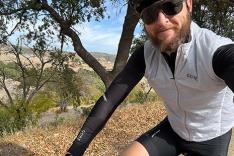Indoor Cycling Classes
With those thoughts in mind, how fast should you pedal on a hill in your Spinning? or indoor cycling classes? While it's true that you want to widen your comfort zone of cadences, we are still talking about ranges between 60 and 110 rpm for most mere mortals who ride bicycles. Back to the tenet of specificity of training, as a cyclist, you want to pedal indoors at the cadences you should be attaining in your outdoor riding. Pedaling indoors at cadences at 50 rpm and below is not specific to real cycling, nor is it very functional.
As I mentioned earlier, if you experienced that outdoors you'd get new gearing if you have any desire to lengthen your cycling lifespan. For this same reason, you want to stay within a reasonable range of cadences in indoor classes as well.
Force reps during the build period of a periodized program might include some big gear intervals below 60 rpm, perhaps down to the low 50s for stronger cyclists, but these should be short in duration, and should not be done if there is any knee or back pain, or if turning the pedals requires any kind of contortion of the upper body.
More: Cycling Cadence 101
What About Non-Cyclists?
Many instructors believe that if their primary population of students does not include people who ride bicycles outside (non-cyclists make up the largest percentage of most Spinning? or indoor cycling classes), then they do not have to adhere to the "rules" that a cyclist would follow.
This kind of skewed thinking boggles my mind, because a non-cyclist's body is the same as a cyclist's body, isn't it? And the same rules of biomechanics and exercise science should apply to both cyclists and non-cyclists, wouldn't they?
So why should the non-cyclists in an indoor cycling class be subject to silly and dangerous moves in the name of "fitness" because their instructor decides they aren't "real" cyclists? In fact, one could argue that a cyclist would actually be more fit and more physically prepared to do these silly moves on an indoor bicycle, but refrains from them out of wisdom and the desire to improve performance instead of hindering it.
With that in mind, here is the general rule that all instructors and students in Spinning? classes should follow: if the movement or technique is bad, ineffective or potentially dangerous for a cyclist, then it is also bad, ineffective or potentially dangerous for a non-cyclist. If a cyclist won't pedal that slow because she's smart enough to avoid the risk of injury, then it follows that a non-cyclist's knees and back aren't any less prone to injury.
Nevertheless, the mindset of instructors who say "but my students aren't cyclists so I can do what I want" is more prevalent in cycling classes than instructors who actually understand the biomechanics and proper training principles of cycling. Let's examine why an instructor might think a very slow cadence with a very high resistance might be beneficial.
Perhaps they think it make you "stronger"?
To answer that, we have to look at the exercise science definition of "strength". In the weight room, a pure strength session involves sets of 4-5 reps to failure. That's not very many repetitions. Furthermore, when a weight lifter increases the reps to 15-20, exercise science tells us that it is muscular endurance that is being developed, and not strength. So when we're talking about someone who is pedaling at 30 to 50 times per minute without breaks, possibly for several minutes at a time, this is not developing true "strength" in the legs. While it is a very low pedaling cadence, it is still a lot of repetitions for the muscles. Therefore, it is folly to think this kind of pedaling will help your leg press. If you want pure strength, then get off the bike and go into the weight room and do squats and lunges.
So if high resistance/low cadence pedaling isn't working on real strength, and it isn't specific to cycling training, and won't improve your performance, what will it do?
In terms of performance, it has no more benefit than pedaling at a safe cadence of 60 rpm, but it may very likely injure you. Instructors and students should always consider the risk versus the benefits of a movement or technique. In this case, pedaling that slow with that much resistance has a very high risk of injury to the knees and to the musculature of the back. Even the upper back and shoulders are at risk if turning the pedals involves heavy pulling on the handlebars. So if the benefits are low and the risk is high, do not do it.
- 2
- of
- 3
About the Author









Discuss This Article